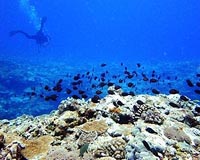| . |  |
. |
Paris (AFP) Nov 4, 2009 Great Whites may be loners, but the ocean's most feared predators also hang out together between Mexico and Hawaii at a deep sea watering hole known as the "White Shark Cafe," a study released Wednesday reveals. No animals inspire more fascination and frissons, but scientists admit to knowing precious little about how the endangered Great Whites get around and get it on as they navigate the globe's oceans. Like other open water sharks prized for their meat -- and, in Asia, especially for their fins -- the magnificent hunting machines are threatened with extinction, according to experts. The new study identifies a distinct population and a major new genetic grouping of the Great White in the eastern Pacific, only the third such "clade" ever found. The other two concentrations of Carcharodon carcharias are off the coast of South Africa, and in the waters between Australia and New Zealand. It had long been assumed shark species at the top of the ocean food chain that roam the high seas looking for food and mates did so almost randomly. But using satellite tagging, acoustic monitoring of shark "hot spots" and genetic samples, a research team led by Barbara Block of Stanford University found -- to their surprise -- that the eastern Pacific's Great Whites are real homebodies. Over an eight year period, nearly 100 sharks were electronically tagged, and even more had tissue samples taken by scientists working from a ship. Not only do the sharks consistently migrate along the same paths, they stick to a schedule too. Between August and December, the Great Whites -- which can grow up to six metres (20 feet) and three tonnes -- stalk waters off the coast of central and northern California, feasting on seals and sea lions. Their preferred hunting grounds in this area are known as the "red triangle", notes the study, published in the British journal Proceedings of the Royal Society B. Starting in January, they head for the deep blue around Hawaii some 4,000 kilometers (2,500 miles) to the west, where they are found in largest numbers between April and July. But some -- especially males -- loiter at a halfway point known as the "White Shark Cafe", with females coming and going for what scientists presume is a bit of shark intimacy. The new findings will help conservation efforts, the study concludes: "The population's fidelity to predictable locations offer clear population assessment, monitoring and management options." A third of the world's open water sharks -- including the Great White and hammerhead -- face extinction, according to the largest ever shark survey, completed earlier this year by the International Union for the Conservation of Nature (IUCN). For decades, significant numbers of sharks -- including blue and mako -- have perished as "by-catch" in commercial tuna and swordfish operations. More recently, the soaring value of shark meat has prompted some of these fisheries to target sharks as a lucrative sideline. Europe is the fastest growing market for meat from the porbeagle and another species, the spiny dogfish. Around 100 million sharks are caught in commercial and sports fishing every year, and several species have declined by more than 80 percent in the past decade alone, according the International Fund for Animal Welfare (IFAW). Share This Article With Planet Earth
Related Links Water News - Science, Technology and Politics
 Taiwan coral reefs need 100 years to recover: scientists
Taiwan coral reefs need 100 years to recover: scientistsTaipei (AFP) Nov 3, 2009 Coral reefs off Taiwan will need up to 100 years to recover from Typhoon Morakot, which lashed the island in early August killing more than 600 people, a scientist said Tuesday. Latest research shows the reefs, near volcanic Orchid Island southeast of Taiwan, have sustained even worse damage than initially feared, according to Academia Sinica, a Taipei-based scientific institution. "Some ... read more |
|
| The content herein, unless otherwise known to be public domain, are Copyright 1995-2009 - SpaceDaily. AFP and UPI Wire Stories are copyright Agence France-Presse and United Press International. ESA Portal Reports are copyright European Space Agency. All NASA sourced material is public domain. Additional copyrights may apply in whole or part to other bona fide parties. Advertising does not imply endorsement,agreement or approval of any opinions, statements or information provided by SpaceDaily on any Web page published or hosted by SpaceDaily. Privacy Statement |